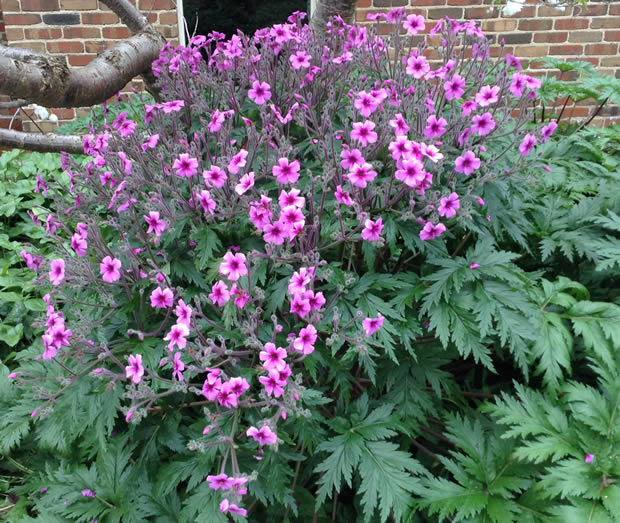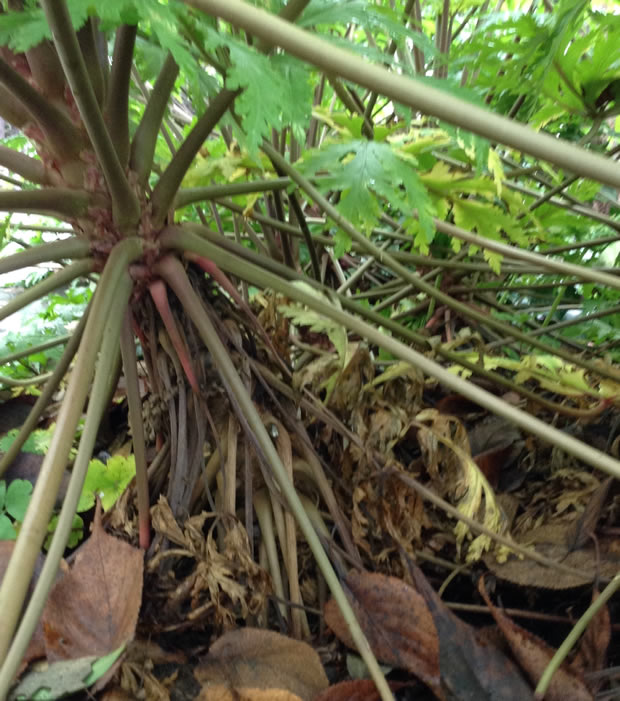A Garden Event worth waiting for. By Kevin Mankey.
Over the last month I have been watching with anticipation the formation of a giant head of flowers on an old favourite plant in my garden, Geranium maderense. This is a very old species of geranium classified as a “true geranium” differentiating it from the many modern hybrid varieties in cultivation today.
 As the name suggests, Geranium maderense hails from the island of Madiera on the north- west coast of Africa. It is a sub-tropical climate with relatively low rainfall and a rocky, craggy landscape. I first encountered this plant whilst touring in the UK back in the late 1980’s. It was growing on St. Michaels Mount, a tiny island land mass off the Cornish coast where an old monastery is now a tourist attraction only accessible at low tide. When I returned to Melbourne I was determined to find this rare beauty to try and grow it for myself but at that time it was barely known here in Australia. By good fortune I was able to get hold of a seedling from a friend who worked in a large private collectors garden in Toorak and my fascination for the plant has continued to grow ever since.
As the name suggests, Geranium maderense hails from the island of Madiera on the north- west coast of Africa. It is a sub-tropical climate with relatively low rainfall and a rocky, craggy landscape. I first encountered this plant whilst touring in the UK back in the late 1980’s. It was growing on St. Michaels Mount, a tiny island land mass off the Cornish coast where an old monastery is now a tourist attraction only accessible at low tide. When I returned to Melbourne I was determined to find this rare beauty to try and grow it for myself but at that time it was barely known here in Australia. By good fortune I was able to get hold of a seedling from a friend who worked in a large private collectors garden in Toorak and my fascination for the plant has continued to grow ever since.
 Geranium maderense is a giant among geraniums, growing to a height of 120-150cm tall by 120cm wide. It is a mound forming evergreen perennial (meaning it does not go into dormancy) with deeply divided hand sized lush green leaves. The foliage alone is textural and interesting but it is the huge flower head that is the real head turner. From early spring a giant beach ball sized head of purplish pink florets, each approximately 3cm across explodes like a firework and is a stunning sight. Each little floret has a dark purplish throat and is covered in tiny inflorescent hairs all along the stem which glisten in the sunlight. The anticipation of these huge flower heads is the sort of thing that tests a gardeners’ patience as it takes two years for a young seed grown plant to reach flowering maturity.
Geranium maderense is a giant among geraniums, growing to a height of 120-150cm tall by 120cm wide. It is a mound forming evergreen perennial (meaning it does not go into dormancy) with deeply divided hand sized lush green leaves. The foliage alone is textural and interesting but it is the huge flower head that is the real head turner. From early spring a giant beach ball sized head of purplish pink florets, each approximately 3cm across explodes like a firework and is a stunning sight. Each little floret has a dark purplish throat and is covered in tiny inflorescent hairs all along the stem which glisten in the sunlight. The anticipation of these huge flower heads is the sort of thing that tests a gardeners’ patience as it takes two years for a young seed grown plant to reach flowering maturity.
Another unique feature of this plant is the formation of props by the lower, older leaf stalks (petioles) which turn downwards toward the ground and serve to prop up the heavy stem whilst also returning water to the root zone around the plant. This is probably an evolutionary adaptation resulting from the poor quality soils where the plant comes from and the fact that it has a surprisingly small root system comparative to the plants’ size.
 Geranium maderense makes a stunning addition to a garden and looks especially pleasing when planted in drifts under the canopy of overhanging trees. It does best when protected from afternoon sun and prefers a well drained loamy soil with moderate water requirements.
Geranium maderense makes a stunning addition to a garden and looks especially pleasing when planted in drifts under the canopy of overhanging trees. It does best when protected from afternoon sun and prefers a well drained loamy soil with moderate water requirements.
Unfortunately it is not an easy plant to find in nurseries as there are hardly any growers who produce it. This puts it in the “collectors plant” category so don’t be frustrated if you can’t find it easily. You may stumble upon it one day and I guarantee the wait will be worth it.
